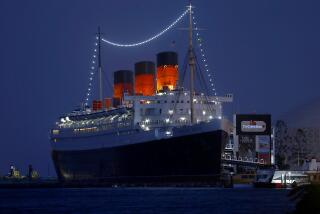Cruise Ships Continue to Multiply
- Share via
If you want to know what optimism is, take a look at a cruise-line executive.
Things are tough in that industry right now. Discounting is rampant as the operators struggle to fill an overabundance of berths.
As the discounts spread, and deepen, yields drop, cutting into profitability. And some ship companies are reluctant to position their liners in what is normally one of the most attractive destinations of all, the eastern Mediterranean and Middle East, because of Americans’ apprehensions over terrorism in that area.
Yet undercapacity and terrorism notwithstanding, those who operate passenger ships continue to invest hundreds of millions of dollars in new tonnage. In the last decade or so, the number of new berths coming on line, each more glamorous than the other, has been impressive.
In the West alone we’ve seen two vessels added by Seattle-based Holland America--the Nieuw Amsterdam and the Noordam. Sitmar gave us the Fairsky, and Princess gave us the Royal Princess.
Back in Seattle, Sundance Cruises gave us the Sundancer, now replaced by the Stardancer and part of the fleet of Miami-based Admiral Cruises. Royal Cruise Lines, in San Francisco, added a ship, and Royal Viking Line, in that same city, stretched its ships by adding a middle section.
That does not take into account the fleet expansion of the Eastern-based companies such as Carnival, Royal Caribbean, Norwegian Caribbean and others.
Still, there doesn’t seem to be any letup in the rush for new cruise ships. One recent week surpassed all others in the volume of new berths announced.
In that short period, Sitmar, which had earlier announced it would build two vessels, upped the order to three, all in the 1,400 passenger range.
Chandris bought the 686-passenger Azur from Paquet Line. Then it disclosed a plan to build one ship and take an option on a second.
Not content to stand pat with its three upscale liners, Royal Viking Line disclosed its intention to build a $125-million, 760-passenger liner as well.
It was left to Miami’s Carnival Cruise Line to upstage them all by breaking the news that it would build one of the industry’s biggest vessels, weighing 70,000 tons and carrying 2,600 passengers, at a cost of $200 million. Carnival, mind you, already has one of the most extensive fleets of all.
All of these new berths, and thousands more announced earlier, will be coming onto the market within the next four or five years, some as early as the end of 1988. What makes the ship-line planners believe the new berths are needed?
The reason for the optimism lies, perhaps, in the boundless potential for the cruise medium. The market is virtually untapped.
Only a tiny percentage of the U.S. population has ever taken a cruise vacation. That’s true, as well, of those segments of the population considered the “classic” cruise market . . . 50 and up, two-income families, retired, affluent.
People who fit into those categories are not by any means the only ones who do or can enjoy shipboard life, but they are generally regarded as the most likely to try it.
Cruise operators believe it is only a matter of time before their promotional efforts cause a significant increase in the volume of traffic, including people who will cruise not just once but over and over again.
Ship lines spend millions of dollars in promoting and advertising every new ship they put in the water. That has the effect of stimulating demand not just for that specific vessel but for cruising in general.
Officials of Cruise Lines International Assn., the trade group of ship lines, figure that demand for their product will almost double in the next five years, from about 2 million passengers in 1986 to more than 3.5 million at the start of the next decade. Thus, to handle the expected additional traffic, officials believe the extra beds really are needed.
But why not wait and make certain?
Simple--if you wait until you can prove the demand, you can’t meet it. You don’t build a ship the way you do a motor coach or even an airplane.
The process of designing, constructing and launching a cruise liner can take more than three years. The operators believe they have to anticipate demand to have new capacity in place by the time people are asking for it.
So the shipyards of France and Finland and Italy and elsewhere will continue to turn out superliners, each one a manifestation of cruise operators’ confidence in the potential for growth in U.S. cruise appetites.
More to Read
Sign up for The Wild
We’ll help you find the best places to hike, bike and run, as well as the perfect silent spots for meditation and yoga.
You may occasionally receive promotional content from the Los Angeles Times.






